HP Memories


By the time I had made the rounds through the Groups and Divisions with the telecom proposal, Lloyd Taylor had been selected to be the new CIO for HP and he was my new boss. He was quite reluctant to make the change I had proposed, but with the broad endorsement I'd received he ultimately agreed. As suggested he did chose Allan Imamoto to take over the Marketing Systems management and Allan did a great job.
In about 1980, as the new communications department was established, and as communications separated from the Heart and Marketing Systems Team, the Office Utilities Group, headed by Luis Hurtado-Sanchez was moved into the communications group to join Comsys, TV, Voice and telephone equipment. So the original Comsys group had grown in size and scope. The group took the name: Corporate Telecommunications and Office Systems (CTOS).
In CTOS, the newly assembled staff set to work defining the projects we wished to undertake. Our general guideline was that any new capability developed should either pay its way directly by replacing existing higher cost activities or facilitate new capabilities for the company that enabled better overall operation that could save money in other areas. This decision served us well. In HP’s annual targeting and budgeting process, while other Corporate functions were struggling to justify their charges to Divisions, I don’t recall ever having a question about telecommunication charges. Here are some of the goals, or activities that the team established:
Office Utilities Group: Personal computers had just recently been developed and were becoming available from an HP product division, at reasonable prices. With these personal computers a rich set of office systems began to be available. Personal computer software could generate spread sheets, word processing, overhead slides and charts with digital projection, along with other helpful efficiency tools. The office systems group under Luis worked to standardize and facilitate the entry of these capabilities into HP as personal computers began to creep into HP offices.
I recall a meeting that Luis's group had arranged with Bill Gates and Steve Balmer where we were asking them to consider a suite of office systems that could run on our engineering work stations using the UNIX operating system just as they did on the Microsoft operating system. Bill thought about it for a minute and then said, "I don't see much of a market developing in the UNIX world," and made it clear that Microsoft didn't want to go there. [I'm not so sure it was bad decision for M/S. They had a clear focus and felt that was their best direction for very high volume marketing.]
Eventually the standardization of software for the PC desktop was transferred to Chuck Sieloff. Susan Green who had worked under Luis transferred with her small group to work under Chuck to develop a Personal Computer/ Common Operating Environment (PC/COE). This saved money on the acquisition and support of new PC software and gave HP PC users common capabilities. Perhaps more importantly PC/COE facilitated the transfer of PC information throughout the company because of the common platform. Another key advantage was any special HP software developed could run on any PC system in the company. For the Users, the benefit was that the standard office desk PC became far easier to troubleshoot and maintain because they were all identical. (Slide below shows the more fully developed desk top of PC /COE under Susan Green and Chuck Sieloff)
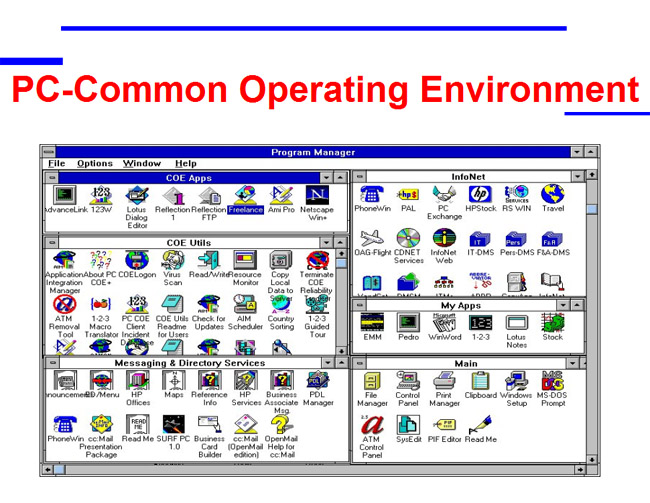 |
The Office Utilities Group was also programming an electronic mail system called Norman for use by HP employees who had PCs. Email could give HP a rich communication tool with person-to-person, on-screen connectivity, where Comsys was a site to site communication tool with hard copy paper at each end. While Norman was still in test deployment, an HP Division in Pinewood, England began development of HP Desk, an electronic mail software product. The Office Utilities Group used their experience with Norman to assist the Pinewood Division in the development of their product and committed to help deploy HP Desk within the company.
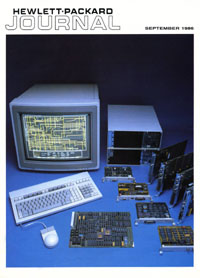
More Information |
This HPDesk effort went very well and the fairly rapid implementation of email within the company helped to explode the deployment of PC workstations throughout HP. (See the HP Journal article) This article describes the remarkable expansion of email from no users in 1982 to nearly all HP employees in 1985. Comsys had been the primary transmission carrier for Comgram messages and was also the first transmission carrier for HPDesk.
When HPDesk was implemented, Comgrams went away and a major cultural shift took place. We each became responsible for our own typing and all of our own electronic filing. This combined with voice mail and the personal computers to make spread sheets, overhead slides and text processing spelled the end of the traditional secretarial position. Computing power had moved out of the computer room directly into the hands of Users. This was a big cultural shift.
Data Networking: The 2100 computer and Comsys transmission had served HP incredibly well for 10 years but by the mid-1980s the commercial world was beginning to catch up. An international data transmission standard, X.25, had finally been approved and several manufacturers were producing products to this standard. We set about, under Doug Avery's supervision, to implement an X.25 network for HP and bought Dynapac switches to connect to GTE Telenet backbone. The small Dynapacs had low switching power and were not fully reliable and they were replaced with carrier grade M/A-Com X.25 switches which had more capability and better network management capabilities. This process began a gradual move of our data transmissions from Comsys to the X.25 network. We quickly learned that this standard, set by a multi-national committee over many years of debate, was expensive and cumbersome and not too much faster than Comsys.
I asked Dell Fischer to go up to HP Labs and Corporate Engineering to look at the XPN and TCP/IP networks they were using to connect some HP Engineers to each other and to universities and government scientific sites. Of all the really bright people in our group, Dell was the one most interested in new technology and was very quick to understand its potential. He spent time with Zvonko Fazarinc and Walt Underwood reviewing their projects. After several meetings Dell came back with a very encouraging report on the Internet capability. It was trim, efficient, flexible, economical and really fast, but the engineers were struggling with the network support and the lack of management tools. As meetings with Walt continued Dell proposed to him that CNS take over the further development and support of the HP internet. Corporate Engineering would be our lead partners. They quickly agreed. Dell's group with a couple of his engineers, Vikash Sachania and Peter Wang, took on the network R&D and support.
Corporate Engineering in the Labs had worked with a little company called Cisco (Yes, the same Cisco of today) in Menlo Park who had a dozen, or so engineers making routers and other related equipment needed to build an Internet network. Some of the first Cisco equipment was prototype stuff. As CNS took over the Internet project we bought more of this equipment and built a small test network up and down the West Coast of the U.S. It worked well and was inexpensive compared to X.25 so Doug Avery, Bill Lund and Hugh Tebault diverted their X.25 efforts to Cisco equipment at a much lower cost and much greater the speed. Both X.25 and HP's Internet replaced 2100 based transmission. Comsys got a new backbone internal network which gave connectivity to all of HP, and in addition, had the potential to connect to the entire outside world as the world became internet capable. It also gave us the potential to access remote databases and processors in real time if they were prepared for this purpose and if we could make the network secure.
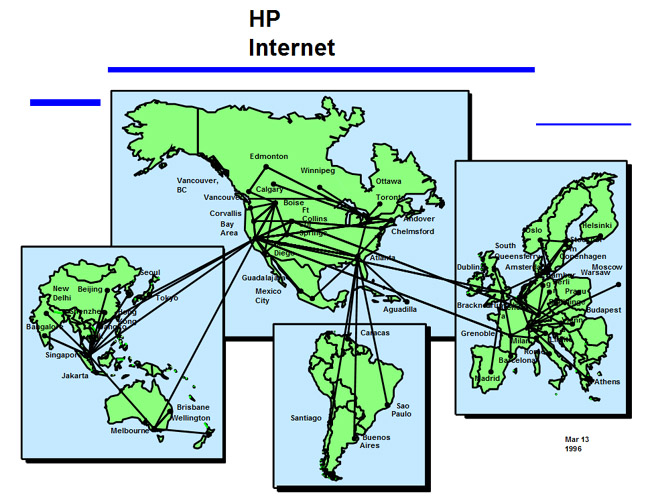 |
| This chart, when shown to our customers, gave a quick glimpse of the geographical spread of HP and the network that connected it all together |
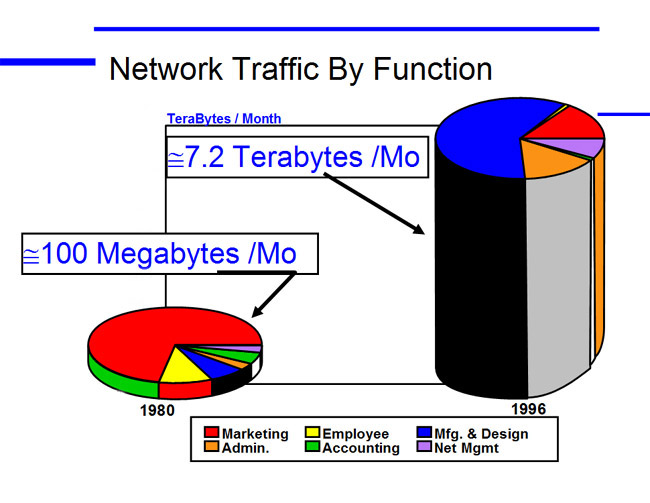 |
| Illustrated here is the enormous growth of our data flows. Transmissions were initially dominated by marketing information which drove the establishment of our earliest networking. Marketing volumes continued to grow over 16 years, but engineering information grew much faster and became our dominant information flow. |
More than 35 years after HP's internet became operational, on a flight to Phoenix, I ran into Hugh Tebault who worked on these projects. He was now the President of the Latham Foundation. Shortly after our visit he followed up with this message: "It was great to see you again, albeit briefly, on our flight to Phoenix from San Jose. This gives me an opportunity to thank you again for your leadership at HP. Working on the new HP network with Bill Lund, Yves Lubino [from Europe], Dell Fisher and Doug Avery was a very instructive and enjoyable time in my career. Your providing us the ability to operate as a virtual startup within HP was key to the success of both the initial X.25 packet network and IP internet that allowed the ROUTS systems to deliver the business information days earlier for HP."
Transmission: Our heaviest data and voice traffic was in the local Bay Area. We found that we could make huge savings by withdrawing from the telephone company and carrying our voice and data traffic over our own microwave network. In 1984 we installed microwave dishes that gave transmission from Palo Alto to Wolfe Road in Cupertino and hit all of our Bay Area sites. This gave us broad bandwidth at a low cost. The microwave network carried all of our voice calls and most of our data volumes.
To complete this installation we needed a Microwave repeater in Mt. View because line of sight transmission was required. The City would not let us erect a microwave tower on HP property in Mt. View, but finally with the help of a Mt. View city councilman who was a friend, they got us a repeater rental spot on top of their tallest downtown building. This was a much better solution than our own tower would have been.
Both we and HP Labs were interested in fiber optic transmission, so we obtained right of way and buried three conduits, two with fiber cable and one with copper cable that connected all of our Palo Alto sites. This took us completely out of the local phone company charges for HP to HP calls and data transmission. The savings from our own microwave and fiber cable quickly paid the investment and returned large savings thereafter.
As the telephone company competition increased, the rental costs of dedicated circuits began to become attractive over long distances. So we began to lease dedicated private circuits from phone companies, between key HP sites yielding even further savings on our voice and data traffic and at the same time allowed us to increase our speed and capacity over the dial-up lines we had been using.
Voice and the Development of TELNET: We felt that we could lower costs and increase functionality of our telephone service if we could standardize our PBX equipment throughout the company. After some evaluation and some selling effort to the field and divisions, we cut down the variety of manufacturers that were used, but we never succeeded on a worldwide basis in getting to a single standard.
The same competition we found in the US began to be felt on international long distance transmission lines. We began to see a dramatically-lowered cost of using private, dedicated lines to connect our sites around the world. Linking our domestic and most of our international sites with HPs own private lines, became very attractive.
This paved the way for us in the early 1980s to have desk-to-desk telephone dialing almost anywhere in the HP world over these private lines. We also produced a global telephone directory about the size of a public phone book, which gave an internal 7 digit number needed to dial virtually any other HP employee directly at his or her desk. This worldwideTELNET service not only made connecting to other employees around the world faster and easier, it substantially reduced our telephone costs. Mickey McNamara who reported to Bill Taylor had the responsibility to put together all the names and phone numbers for the printing of the Telnet directory.
The directory production was a big job and took a lot of proofing. Mickey decided one day to make her job a little more interesting, so she took her current print ready pages to the printer and had them run off and bound. Before the last book was bound she asked the printer to assemble the last directory with one page changed. That page had Bill's name and phone number. In that last directory Bill's line read Bill "Hot Lips" Taylor. The boxes of 70,000 - 80,000 good directories were already shipped around the world and Mickey delivered her special copy to Bill's desk. As most of us tend to do, he looked up his own name to see if it was correct only to find Hot Lips . He nearly had a stroke as he envisioned 80,000 directories with Hot Lips all over the world. He only calmed down after he had checked half a dozen other directories and found them to be OK. It takes a confident manager to take a joke like that, without any kind of retribution.
Voicemail: By the 1980s HP had begun to make use of voice recording machines on the desks of many individuals. The huge time zone differences around the world made leaving voice messages an efficient way of dropping off information and getting timely replies back. In the mid-1980s, Octel, a small company in Milpitas had developed a product that connected directly to most any PBX which offered the same answering service as a desk top recorder, but had many additional capabilities and would cost less per person than continuing to buy individual recording/answering machines.
Tests of the product proved to be very positive and we gained approval to begin deployment of these throughout the company. In addition to answering and recording incoming calls, it allowed you to respond to a recorded message you received and send your recorded answer back to the caller's in-box. Voice mail also allowed the caller to send a recorded broadcast message to a list of voice mail boxes or simply send a message to a person without calling them. This was very helpful when the time zone difference was great. It also allowed you to manage lists of frequently called people and easily send a message to that list. This was a very useful set of capabilities, especially for teams of people who worked together frequently, but were scattered over many time zones. Voice mail was deployed worldwide over a short time span in the late 1980s.
Teleconferencing: Also in the early 1980s, satellite TV broadcasting was established in HP when satellite transponder time became available. HP added to their excellent TV studios, where training films were created, the ability to originate broadcast programming to North America and then a little later to the whole world. Jim Hodel worked out the installation of receive-only satellite dishes at about 50 of HP's major sites around the U.S. Over time this was expanded to 131 receiving points world wide by 1997. This video network made possible live broadcasts which introduced new products, gave training to our field support people, allowed Honors Coop courses taught by Stanford faculty to be broadcast to HP engineers around the globe and facilitated other kinds of training and announcements to worldwide HP audiences. The TV broadcasts were outbound only, but arrangements were made for telephone links back to the studio which allowed questions to come back to the presenters from the entire audience, with the questions and answers heard by all.
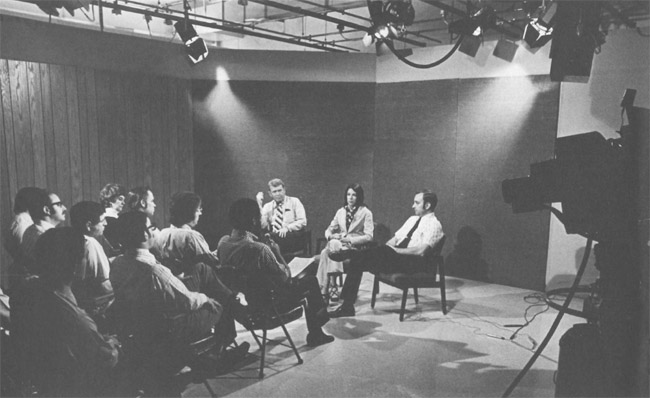 |
| Origin point of a video broadcast. Courtesy of the Hewlett Packard Company |
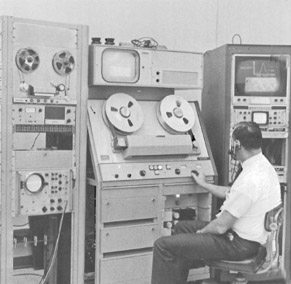 |
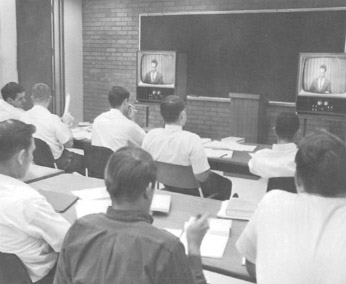 |
Back Room monitoring of a video broadcast |
This classroom scene is typical of a Stanford Coop Engineering |
Audio Conferencing: During this time frame voice teleconferencing became common at HP. High quality speaker/microphones were used in conference rooms to allow meetings with participants around the world.
Video Meeting Rooms: Then in about 1989 six conference rooms were equipped as two way video meeting rooms. We developed some software to simplify the controls on the HP 150 desktop computer which allowed camera positioning to be adjusted by the moderator from a touch screen computer.
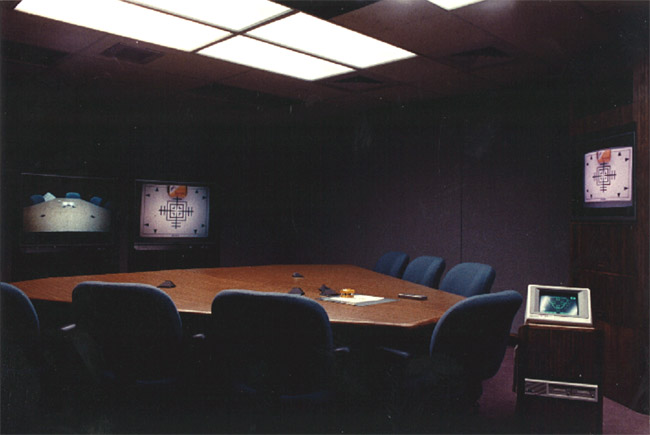 |
| This is a two way video meeting room with an HP150 touch screen PC programmed to control cameras at the moderator’s touch command Courtesy of the Hewlett Packard Company |
When my children were asked, "What does your dad do?" their standard reply was, "He works at HP." If questioned further they always said, "I don't know." I thought this was a little troubling so for one of our weekly family meetings I hauled the whole family up to HP, at 3000 Hanover, in the Stanford Industrial Park and took them into this video conference room. There I used slides, hand-outs and illustrations as I went through my most understandable projects and invited them to ask questions. They were attentive and I thought at last they had some grasp.
The next time I overheard one of them asked, "What does your dad do?" the answer came back "He works at HP and he's a manager or something." So much for my fancy conference room briefing.
Desk to Desk Video: Early work was done on desk-to-desk video and testing was done at a number of HP sites. It was useful, but never proved to be very economical in the early days. 30 years later Skype did successfully what we were struggling to do.
Cell Phones: In the early days of cell phones Bill Taylor saw the proliferation of cell phones, especially with our field sales people and the attendant rise in telephone expenses. Mike Lovell in the field organization wanted to get better control of cell phone costs. He worked with Bill to negotiate agreements for the hand sets at very much better prices than the individual offices were getting before and then worked out carrier provided airtime services also at deeper discounts.
Chuck House, again in his book notes, "Roxanne Hiltz (of The Network Nation ) had already proclaimed HP's email network, to be the second largest corporate communication network on the globe (1981); with these voice and video connections, it had arguably the most comprehensive network in the world, amazing for a company ranked Sixtieth in revenues in American industry."
In the early 1980s when our telecommunication plans were quite well developed and some early implementation had begun I was asked to make a presentation of our plans to the annual HP off-site management meeting, held this year in Sonoma, CA. The Group Managers and Division managers that I had talked with about the idea of establishing a Telecommunications group were there along with many other Company leaders. The presentation of the plans was very well received and when the boistrous applause settled down David Packard rose to his full height and said, "These are good tools, but I hope we don’t forget that personal contacts are the important thing." Suddenly I flashed all the way back to the old pneumatic tube proposal, a lifetime earlier. This time however I knew that personal relationships were the primary key to a successful organization and all the planned communication tools were just supplements.
Shortly after the management meeting I was invited to make a presentation to HP Board of Directors. Packard was still the Chairman and Hewlett was Vice Chairman and John Young was the President and CEO. The presentation went well and the board was favorably impressed with our direction. During the presentation the Board members were very attentive, but Packard looked sleepy. He caught me afterword and explained that he had just gotten back from China late yesterday and his internal clocks were still off kilter.
Because we were making a number of strategic investments in equipment and infrastructure the Board review was needed and we were happy to have their support.
By the 1990s all of the activities described above had extended to virtually every HP location around the globe, which presented some problems of consistent, seamless operation of these services. After some evaluation we formed a global organization to manage and operate these services with about 400 people in all of our key sites reporting as part of Corporate Network Services. With excellent people throughout the organization things ran smoothly. Serge Guibout-Riboux in Geneva managed CNS people and activities in Europe and reported to me with full support of Dominique Courcoux, the European IT Manager. Similarly Bessie Mok in Hong Kong managed people and services in Asia with the full support of Rick Bergan, the Asia/Pacific IT Manager. One of the very simple things that we did was to make a T-shirt with everyone's name imposed on a world map and gave one to every person in the organization. It was an inexpensive gift but turned out to be a unifying symbol of global teamwork.
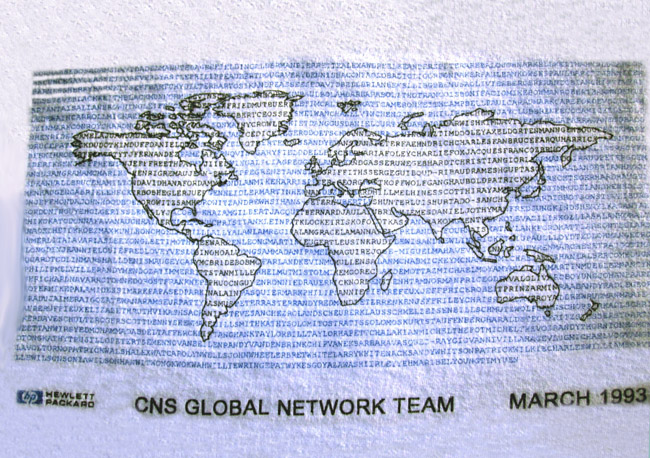 |
| All 400 names were printed on the global team's T-shirts |
Dean Hall in our Palo Alto CNS Staff spent a great deal of his time traveling in Europe and Asia to keep our far flung organization tightly linked. He did an amazing job at this and provided an important two-way organization information conduit. Dean loved to travel and I didn't, so he went often, and thereby filled a critical role. With all his travel he was a student of frequent flyer deals. Phil Wilson, who managed Bay Area EDP was also a travel guru, having supervised the HP's travel department for some time. He and Dean came across a bargain they couldn't pass up, so they took a whole weekend day and made a seven leg, airline circle tour around the Western U.S. to get some amazing flight reward.
To help the group function as a single unit we used a lot of own communication tools with good results. Periodically however it was important to have personal, face to face meetings; so a small group of key network managers traveled to Geneva, Grenoble, Boeblingen, Atlanta, Tokyo, Singapore, Hong Kong, etc. While there we worked on problems and set future directions. When in these remote locations we included as broad a group of local Networking and IT people as was practical.
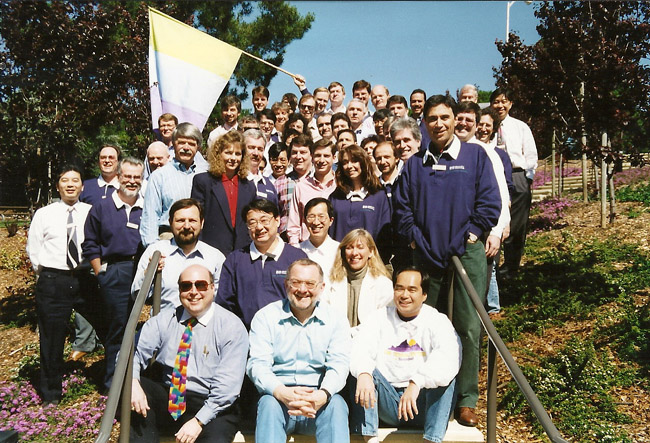 |
| A Corporate Networking Services meeting in Singapore including local networking and IT people. Early 1990s |
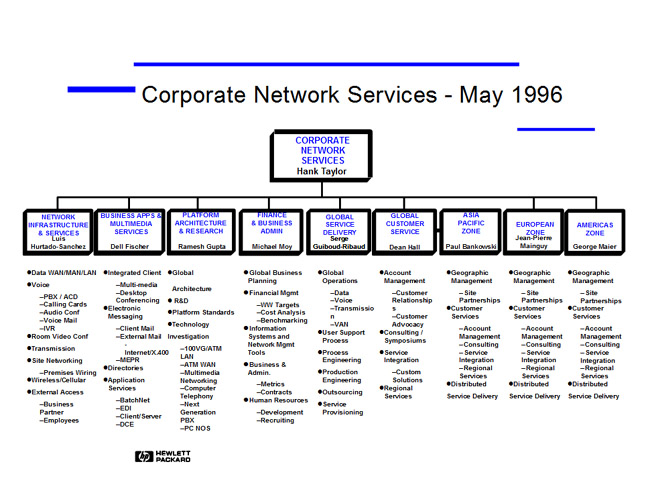 |
| The 1996 chart of the worldwide network organization |
In the early 1980's HP had developed a solid reputation for pushing the telecommunication activities of the world forward and as a result I was persuaded to participate in an external focus group. The sponsor was not made known to us, but was likely a telephone company. A number of topics were covered, but the key issue was to determine what the use of high bandwidth transmission would be after it could be deployed. They defined "high bandwidth" as something just over 1.4 mb per second; they called this T-1 service.
The group fumbled around for a while trying to imagine how businesses or individuals would use this much bandwidth. When I couldn't stand it any longer I raised my hand and said, "T-1 service is barely at the low end of high speed transmission and the activities which will drive bandwidth requirement well beyond this are in the entertainment area: pictures, videos, movies, games, music, etc. That day will come soon and when it does T-1 bandwidth will be almost uselessly slow." The moderator became very uneasy, quickly changing the topic and was unwilling to call on me further during the remainder of the session.
As the HP 3000 became a stronger and stronger processor, Cort Van Rensselaer had the vision to see that developing manufacturing systems on this platform would have several advantages to the company. It would give us a show place for customers to see our computers in action. Secondly, with just one computer system instead of many, it would give us a common development platform for internal system development. Prior to this, divisions had a variety of computers to run their manufacturing systems and even a greater variety of software.
It took a good deal of effort, but Cort’s group developed a set of systems for manufacturing divisions on the HP3000. These systems were broadly accepted by divisions and HP became more standardized in our computer processing, systems development and support became much more efficient.
It was a bit later when Allan Imamoto made the leap of faith and with his team worked out a way to process Heart on the HP 3000. All these conversions turned out to be a very good thing for the company.
During my years with Heart and Corporate Networking Services HP was expanding from the manufacture and sale of engineering products into the business computer market. John Young, the CEO of HP said, "It was hard work; believe me, just getting customers." We were selling to people we had never sold to and at the highest levels in their corporations where we had seldom made contacts before. John said, "IBM owned every company outside of the lab or the factory floor."
The solution to breaking into new companies turned out to be bringing high level executives to Palo Alto to attend HP management seminars where they were introduced to our actual information systems processes. It seems like I was making a presentation, along with many of my fellow IT workers, weekly. These presentations had the credibility of hearing from someone who had actually done the things the customers wanted to do. Heart, Comsys, Manufacturing and Accounting systems were all very impressive to our visitors. This networking summary chart is the one that I used for some customer presentations. It was updated year by year.
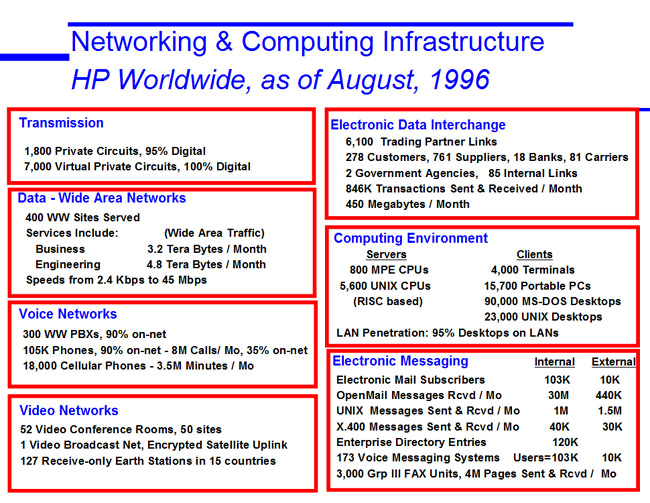 |
| This networking summary chart is the one that I used for some customer presentations. |
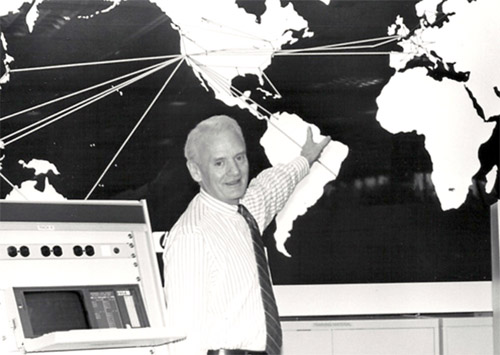 |
| Hank in the Comsys Network Control Center |
John said, "We had a lot of great data. That was one of the most powerful selling tools ever [in selling to high level manager] because we had zero credibility in big corporate IT places." John went on to say, "On a daily basis HP could get sales [data] from around the world - product by product, office by office, the next morning. The notion that you could get that in 1975 was crazy for any other company. We had the order processing system, the order transmission system, and email that layered on that. It was the leading-edge worldwide system. It was remarkable. We absolutely had great control of our business." (From a Chuck House interview with John Young; from his book The HP Phenomenon)
As we began talking to customer regularly John explained that we didn’t have to be excessively careful about revealing our administrative processes or performance data. His observation was that HP’s organization, people and processes allowed us to do things that most customer organizations simply could not duplicate.
Sometime in the mid 1980s, Dave Packard who was still the Chairman of the Board said that he had a very unhappy customer contact him and he asked me to solve her problem. She had purchased one of HP's early personal computers and integrated its text processing into her little business. The operating system and text processing program had become corrupted in a partial crash and needed to be restored. Both her hardware and software had been obsolete for some time and HP's service organization had retained no obsolete software copies that could restore her system. Because of her distress they even offered a new PC with upgraded software. She wanted no part of that solution. She liked her system just as it was and simply wanted it back. When I talked with her it became clear that no other solution was acceptable.
I talked to dozens of IT and Lab people to see if they had any ideas for a work around, or other solution. Finally someone mentioned Ainsley Frederickson, the assistant to Jack Brigham in HP's Legal department who, to the best of their knowledge had never thrown anything away. She was a stately woman and graciously took the time to listen to my problem. "I might be able to help you," she said tentatively. Next thing I knew this dignified woman was crawling under her desk where under the right pedestal was a fair sized cardboard box. She pulled it out and we sifted through the contents. There were dusty manuals, a cable or two and old floppy disks. In the bottom of the box, like a hidden treasure, was the obsolete operating system on a small disk, along with the text processor software. She allowed me to take it to make copies. I sent one disk to our customer and asked her to keep it safe for backup. She was thrilled to have her problem solved.
It was impressive to me that a very small customer who would never even show up as a blip in our sales statistics got Packard's personal attention.
One of the ongoing problems of any corporate group is to be able to demonstrate to itself that it is providing value, and further, to be able to demonstrate this to the profit centered divisions of the company who must bear the cost of those services. I remembered clearly my feelings of bearing the weight of corporate overhead charges in a small struggling division. With this in mind I told our group that if we couldn't prove to ourselves that we provided a needed service, giving tangible value to divisions at a lower cost than they could get elsewhere, then we should be disbanded. We did not allow the cost of our services to flow into the corporate overhead charges, but rather billed our charges directly to divisions as a specifically measured service usage, such as telephone voice minutes used, TV broadcasts hours used, mb of data transmitted and so forth. This allowed divisions to check outside alternatives for cheaper or better service.
To make the CNS effectiveness very clear to ourselves, as well as to our divisions, who paid the bills, we decided that we should benchmark our services with the best-in-class companies who would be willing to compare the cost of services with us. I asked Chandran Sankaran who worked in our group (and later became an outside management consultant) to see if he could set up a benchmarking meeting with other companies and asked Bill Taylor to supervise the process. With some excellent work Chandran found a number of companies who were as interested as we were in benchmarking. The following were some of the first participants: Boeing, DEC, IBM, 3M, Motorola, Cargill, Lexmark, Control Data, a couple of banks and others, about 10 in all.
What we found was that our cost per mb of data transmission was significantly below most of the other companies in our benchmarking group. Normally we were the lowest, unless there was a company that had very centralized functions, or restricted geography to cover. Our worldwide voice costs per minute were quite a bit lower than the others, except for Boeing whose telephone traffic was primarily on two major U.S. campuses and almost no international voice traffic. Our email costs per message were well below others in the study group and so on.
The result of the benchmarking was very positive. All of us who participated picked up new ideas and for HP. It was gratifying to learn that our telecommunication services were by far the most complete, best measured and providing strong services to users. It was helpful to be able to talk with our divisions and business groups and show that our costs were nearly the lowest of the participating companies in every area. There were a few exceptions for very centralized/geographically limited companies as in the case of Boeing's telephone cost per minute and a few other similar cases.
One important thing that we learned from benchmarking was that the fewer geographical places a company performed a function the less that function would cost. This was true for all companies who benchmarked with us. This concept was important to HP as expense controls became aggressive.
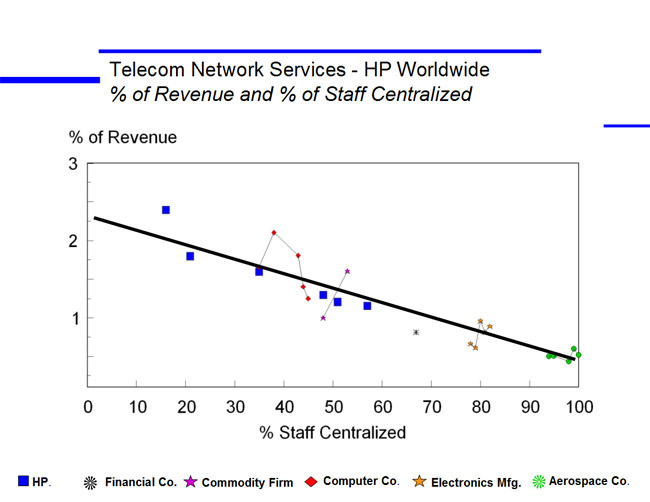 |
This chart shows several interesting things: First, HP’s total Telecom costs as a percent of revenue were the highest of the companies who benchmarked with us. There are three main reasons for this:
While our total measurable costs were higher than the other companies, the cost of each of our services was generally the lowest of those in our benchmarking group.
Another significant thing was confirmed in our benchmarking. It was that whatever we could do over time to centralize our telecom management thru the use of network tools did lower our costs. The blue squares coming down show the 6 year effect of our centralizing efforts. Also the most centralized companies had the lowest costs and even these came down as they centralized functions more.
Bill Taylor continued this benchmarking activity after I retired from HP in 1997 and the process continued even after Bill Taylor left in 2002. I don't know if benchmarking is still in use.
In the late 1990's, HP came under even more severe competitive pressures and began a long, intense siege of cost cutting measures. Lloyd Taylor the Chief Information Officer was looking for ways to make significant cost reductions in HP's total information processing. I recall one budgeting session where Lloyd asked us to terminate a global directory project that we had just begun and remove the costs from our next year's budget. We did take out the cost from our spending plan, but quietly and more slowly continued the directory development. Lloyd was somewhat aware that we were bootlegging the work, but never said anything. It was sort of a tacit acceptance that it would stubbornly go forward.
The project under Bob Horowitz, was to create an on-line directory which would contain information from multiple sources and make that information available to our people and to related computer processes. We recognized that printed directories were out of date as they rolled off the presses and drifted as much as 10% per month. The project was to create a repository for names and phone numbers to replace the printed Telnet directory, and also list global email addresses, employee numbers, maps, organization charts, distribution lists, fax numbers, mobile phone numbers and more. In a central database this would be updated twice a month rather than once or twice a year. In addition to providing user look-up, this directory became an integral part of the IT infrastructure as programs accessed it for authenticating parts of their process or for automated routing etc. For example if you had an analytical output from a computer process and wanted it to go to all finance managers of a certain level, the directory would tell you who they were at this time and apply the routing information to distribute the reports.
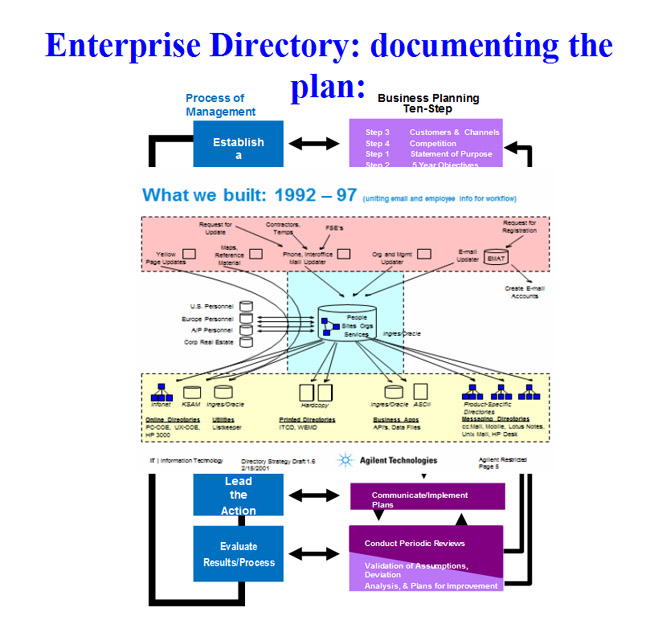 |
Much after Lloyd left HP to take a top management job at Cargill he hit some people tracking problems. He called and asked if we ever completed "Our doomsday directory." I said, "Yes, certainly enough to be very useful." He said, "Good, can I send a couple of people out to talk to you." Bob Horowitz hosted a two day meeting with a couple of Lloyd's managers. Bob said it was somewhat discouraging for them because HP had so many of the building blocks in place to start with, where Cargill was starting near ground zero with significant organizational barriers.
The cost squeezes in HP continued. By this time our internal internet was robust and fully deployed and fairly manageable. Within the company we had access from any desktop to virtually any computer processor anywhere in the world. Mike Lovell in the management of the field sales operation caught me one day and asked, "Will the TCP/IP network allow any PC in any field office to access a computer room in a remote location? If so could I replace 60 small computer rooms with one larger one?" I said, "Absolutely, that's why we built the network." He said, "Great, I want to do it." Atlanta became the U.S.field data center and all the field desktop computers could connect to that center. The small computer centers in the scattered field offices were closed yielding great savings and better service.
Lloyd continued to be concerned about cost reductions and had pressure from upper management to keep cutting. I went to talk with him and suggested that we could close all of our factory computer centers except for 1 or 2 and provide as good, or better service to the company than we had now, much as the field had done. At the time of this proposal almost every division had its own data center. These were larger and more complex than the small field office data processing rooms. I believe there were around 50 factory data centers at that time. Reducing the number to one or two would have massive savings to the company overall. I explained to Lloyd that this was a perfect use of the network and that our processing would be more reliable and better managed.
Lloyd listened respectfully, but showed no immediate sign of moving forward in this direction. Because it was a huge takeaway from sovereign divisions, he hired McKinsey & Co to come in and do a general study. I talked at length with the McKinsey people about the idea of data center centralization. They were shown the capabilities of our worldwide network and I gave them my rough estimates of very large cost reductions, probably on the order of $150 million per year. McKinsey interviewed many other IT people and line managers. Their study concluded that the centralization was indeed the right direction for HP to get significant cost reductions with better, more secure and reliable computer services. Of course their proposal was thick, nicely bound, had charts and graphs and they made a number of management presentations. Management approval was given and the consolidation was successfully made. I'm sure that Lloyd felt that the weight of expert analysis was needed to pull this off. McKinsey's credibility may well have justified their pricey billing. By 1995 HP's networking facilitated other structural changes as well. Note some of these changes in the chart below.
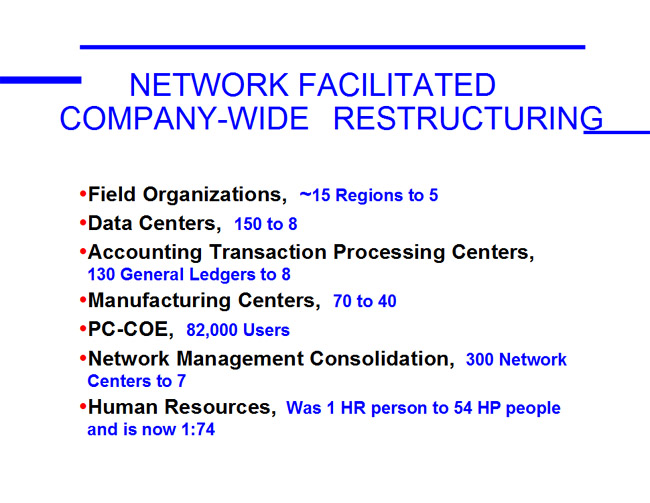 |
The last major project I asked CNS to undertake was to create a network gateway to allow HP, as a company to connect broadly to the outside world. We needed to address a myriad of security issues, but the intent was to provide specific kinds of access from and to our customers. We also needed to connect and interact with our distribution channels. Similarly we would need access to our vendors and they to us. Employees would need access from their homes to the office. We would have outside business partners and service providers with whom we will need two way access. There will be information sources that we need to access. This was a daunting task, but with the work of Dell Fischer and many others in CNS gateway services were established to create a rich set of connection that were adequately secure.
With the advent of networking beyond the boundaries of a company, substantially more dramatic changes were in store. See the slide that laid out the objective.
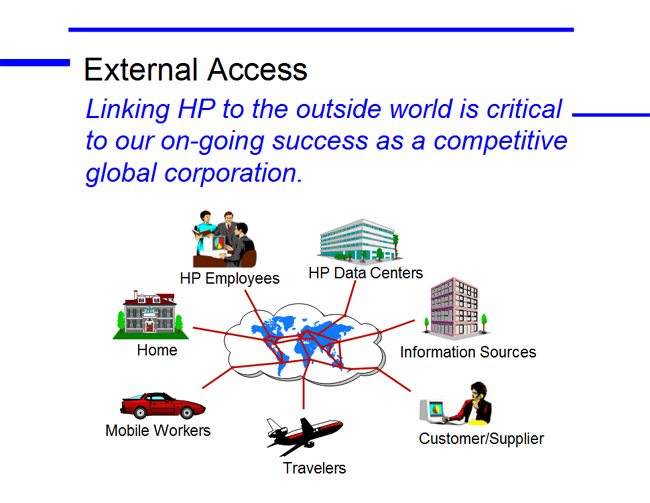 |
I always felt generously compensated by HP for the work that I did. Because it was a joy to work in this environment, among outstanding people this feeling was even more intense. Because we had been treated so well, I felt the obligation to give something back to the world community as Dave and Bill had done in such an exemplary way. As a result Colette and I established a trust to benefit the Universities we attended and then specifically to give support to two organizations. These were the Boy Scouts of America and the LDS Church Perpetual Education Fund.
BSA: Our 5 sons were all Eagle Scouts and our foster son who came to us a little too late to reach Eagle still advanced well into scouting and his life was enriched by the experience. Our three daughters have raised and are still raising eagle scouts of their ownand our sons are as well.
The Perpetual Education Fund: is established to help younger people in less developed countries to gain an education and employable skills. So far it has helped 53,000 people in 52 countries to substantially increase their earning power, lift them out of poverty and improve their ability to support their families. The assistance received is treated as a loan and is paid back into the fund to help others. Most all of those helped are current with their loan repayments and their repayments are immediately available to help others. Because much of the administration of this program is volunteered the administrative costs are near zero.
Gift of Land: I was the managing partner of a group that owned 160 acres of virgin redwood land in the Santa Cruz mountains. As the partnership came to a close I was able to arrange a transfer to Save the Redwoods who in turn gave the land to Portola State Park. A significant portion of this transfer was a gift to Save the Redwoods. We were happy that the land could get broader public use and the virgin trees could be preserved.
Colette and I have been very grateful that we are able to help with the support of these worthy activities.
When we made the decision to come to Palo Alto for me to join HP in 1957, I had no idea that I would get to work for such a great company and have so much satisfaction in the work that was to be done. The atmosphere and personality of the company over a 40 year period were delightful beyond any reasonable expectation. Much of what was good about the company, I believe, flowed from Dave and Bill and I am just grateful that I had the chance to work in their company during what turned out to be a golden era.
I never had any allusions of changing the company, or its culture. Over the years my consistent personal goal was simply to make things easier, faster and better. It was my great fortune to work with talented people who could create the tools to make this happen. The company culture created a marvelous environment for change and progress. We were all influenced by innovative lab developments and the constant flow of new products. HP people expected that all things can be improved. This included not only the endless flow of new and improved products, but also better information flows, faster processes, and less expensive administration. We all believed that we had, or could create the tools to make each of us and the company more productive. This was a winning culture and a delightful one in which to be employed.
I apologize that this account is sketchy and incomplete, leaving out many outstanding HP contributors that I worked with and omitting their significant results. Nevertheless I hope that from this partial account one can gain a feeling for the exceptional nature of Hewlett-Packard Company as I knew it.
My profound thanks to John Minck and Marc Mislanghe for the motivation they provided to record my story and for all the support and enhancement they provided to get to the final product.
Palo Alto
CA, 2012
Hank Taylor